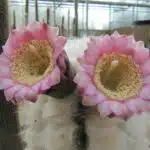The Ruby Ball Cactus, often referred to as the Moon Cactus, is a unique and beautiful specimen of nature. It is a unique cactus, in that it needs special care in order to thrive. Think of it like a new-born child; delicate and fragile yet with the potential to grow strong. With the right amount of love and attention, this succulent can be a source of joy for years to come.
This article will provide you with all the information you need to properly care for your Ruby Ball Cactus. From watering tips to propagating advice, you will learn how to nurture this miniature masterpiece so that it can reach its full potential. We will discuss which soil types are best for this type of cacti, as well as how much sunlight and water is optimal for growth.
Finally, we will discuss some common issues that may arise when caring for this succulent and provide simple solutions so that you can keep your cactus looking its best! Whether you are an experienced gardener or just starting out, this guide will help you give your Ruby Ball Cactus the tender loving care it deserves!
What Is A Moon Cactus (Ruby Ball Cactus)?
A moon cactus, also referred to as a ruby ball cactus, is a unique type of plant that has become increasingly popular in recent years. It is an example of grafting, in which two different species of cacti are joined together to create one. The top portion is typically a bright and colorful Gymnocalycium mihanovichii while the bottom portion is usually green and will provide the root system for the plant. They make for a striking houseplant that can add life and color to any room.
The good news is that caring for a moon cactus isn’t too difficult – they are great low-maintenance plants! First off, it’s important to find the right location. Moon cacti thrive in bright light but direct sunlight should be avoided as this can cause sunburns or even death. A south facing window with sheer curtains is ideal. Watering needs will depend on how hot and dry your home environment is, however they generally require less water than other plants. When you do water, make sure it drains completely from the pot so that the roots don’t sit in standing water; this could cause root rot or fungal disease.
When it comes to soil, choose a well-draining mix specifically for cacti and succulents – never use regular garden soil as it does not have adequate drainage abilities for these types of plants. If you notice any brown spots on your plant, don’t worry – this could be caused by cold drafts or too much fertilizer; simply trim away any discolored areas with sterilized scissors and refrain from further fertilizing until new growth appears. With these tips in mind, you’ll be able to keep your moon cactus healthy and thriving!
Where To Find A Moon Cactus
Moon cactus, or the ruby ball cactus, is a truly spectacular sight. Its striking red and yellow coloration can fill any room with eye-catching appeal. But in order to get the most out of your moon cactus, you need to know where to find one.
Fortunately, moon cacti are widely available from nurseries and garden centers. You can also purchase them online from specialty suppliers. If you’re lucky enough to live in a warmer climate, you may even be able to find them at local farmers’ markets or roadside stands.
When choosing a moon cactus, look for one that has an even color pattern and is free of blemishes. Also ensure that it has been properly grafted onto its rootstock so that it is firmly attached and won’t come apart easily. With the right care and attention, your moon cactus will reward you with years of beautiful blooms!
Choosing The Right Container
Choosing the right container for your Moon Cactus is just as important as selecting the right soil or getting enough sunlight. It’s a crucial step in helping your Ruby Ball Cactus thrive. To illustrate this, consider the analogy of a house: it needs to be structurally sound and capable of protecting its inhabitants from the elements. Similarly, you need to make sure that your Moon Cactus has an appropriate container to live in.
When selecting a container for your cactus, there are several important factors to consider. Firstly, make sure it’s deep enough that the roots have plenty of room to grow; otherwise, they can become root-bound and stunt the plant’s growth. Secondly, pick a container with drainage holes at the bottom so excess water can easily escape – if there isn’t enough drainage, the roots can become waterlogged and rot. And lastly, select an appropriate material – terracotta pots are ideal for cacti because they allow air to circulate around the roots, but plastic containers also work well.
Once you’ve chosen the perfect pot for your Moon Cactus, it’s time to move onto preparing the soil – an equally important step in keeping your Ruby Ball Cactus healthy and happy!
Preparing The Soil
How can you ensure the success of your moon cactus? Preparing the soil is a key step in growing any type of plant, and grafting a ruby ball cactus is no exception. What steps should be taken to create the perfect environment for this unique plant?
First off, it’s essential to understand that moon cactus prefers a well-draining soil mix. When preparing your own mix, use a combination of three parts potting soil and one part coarse sand or perlite. This will help ensure your soil has sufficient drainage to prevent root rot. You may also wish to add some fertilizer designed specifically for succulents and cacti to maximize growth potential.
It’s also important to make sure your pots are clean and free of disease before planting. Make sure they have good drainage holes in the base, as standing water can cause serious issues with root health over time. Once you have prepared the soil and prepped the container, you’ll be ready to start planting!
To truly get the most out of your moon cactus, it’s essential that each step in its cultivation is done correctly. With these tips in mind, you can be sure that when it comes time for planting, all conditions are ideal for successful growth and thriving health.
Planting Your Moon Cactus
Planting your Moon Cactus, or Ruby Ball Cactus, can be an exciting endeavor with a little planning and preparation. For those who have been looking to cultivate this plant, it is important to understand the nuances of planting in order to ensure healthy growth.
Take the example of one gardener who was determined to get their Ruby Ball Cactus off to the right start. When they finally found the perfect spot in their garden for their new cactus, they prepared the soil using compost and sand to ensure good drainage. This was essential for optimal root health and nourishment that would allow for successful growth.
Once the soil was ready, it was time for them to begin planting. They made sure that the cactus was planted at least twice as deep as its current container size so that it could establish a strong base in its new home before developing upward. After making sure that all areas were firmly packed down, they provided some additional water to help with settling in and encourage growth.
With patience and dedication, this gardener’s Moon Cactus has now grown into a lush addition to their garden landscape – something that wouldn’t have been possible without proper planting techniques. Now that we know how to properly plant our own Ruby Ball Cactus, let’s look into some watering tips for keeping it healthy!
Watering Tips
Watering your moon cactus is like giving it a sip of life-giving nectar. It’s the most important part of caring for this gorgeous, grafted gem. Like many desert plants, watering too much or too little can cause serious damage. Here are four tips to get the balance just right:
- Water moderately and infrequently – about once every two weeks. 2) Move your cactus out of direct sunlight while you water it – this will help prevent sunburn and dehydration. 3) Use lukewarm water that has been allowed to sit at room temperature overnight – cold water can shock the roots. 4) Put your cactus in a small saucer filled with pebbles and add lukewarm water to the saucer – this will ensure that the soil is evenly moistened.
These guidelines may seem simple, but they are essential for keeping your moon cactus healthy and vibrant year after year. Remember that over-watering can cause root rot and other serious issues, so err on the side of caution! With proper care and attention, you’ll be rewarded with a stunning ruby ball cactus display all season long.
The next step in caring for your moon cactus is getting its sunlight requirements just right. The key is to provide bright light without overexposing it to intense heat or sunburn…
Sunlight Requirements
Sunlight is a fundamental requirement for the Ruby Ball cactus, as it is with any cactus. When well-lit, this plant will reward its owners with vibrant red or purple coloration. As such, it’s important to find an ideal location for your Ruby Ball cactus. When considering the ideal spot for your new plant, remember that these plants need strong, direct sunlight for 4-6 hours per day in order to thrive and develop their signature coloration.
A south-facing window can provide strong direct sunlight which should satisfy the needs of your Ruby Ball Cactus. If a south-facing window isn’t available, east or west windows can also provide adequate light intensity and duration but may not support maximum coloration. Additionally, plenty of indirect sunlight should be available at all times. If the amount of direct and indirect light isn’t sufficient enough to meet the needs of your Ruby Ball Cactus, you may want to consider investing in artificial grow lights that are designed specifically for plants such as this one.
It’s essential to ensure that the lighting conditions aren’t too intense; otherwise leaves may start yellowing or burning due to overexposure to the sun’s rays. If either of these symptoms occur, move your plant to an area where it will get less direct sunlight and more indirect light instead. By following these guidelines you’ll ensure that your Ruby Ball cactus gets just the right amount of sunlight needed for optimal growth and development.
Correctly managing sun exposure can go a long way towards ensuring healthy growth and vibrant coloration in your new Ruby Ball Cactus! With just a bit of trial and error you’ll soon discover what works best for you and your new botanical addition! Next up is fertilizing & feeding – another key component in keeping this beautiful succulent thriving!
Fertilizing & Feeding
Fertilizing and feeding a moon cactus is like giving a car a tune-up. It’s important to give your plant the right fuel and keep it running smoothly. When done properly, fertilizing and feeding can help your moon cactus thrive.
First off, you’ll want to use a balanced fertilizer specifically formulated for cacti or succulents. These fertilizers provide the necessary nutrients that the moon cactus needs while ensuring the soil doesn’t become too concentrated with minerals. For best results, apply fertilizer every four weeks during the active growing season—spring through early fall—at half the recommended strength.
When it comes to feeding, it’s important to be mindful of how much water you’re providing your plant. Too much water can cause root rot and other issues, so make sure you’re watering your moon cactus only when the soil has dried out since its last watering. Additionally, try misting your plant occasionally with non-chlorinated water to provide extra hydration between waterings.
With adequate fertilizing and feeding, you’ll find that your moon cactus will begin to grow healthy leaves and stems in no time at all. Adopting these practices into your routine will help ensure that your ruby ball cactus stays strong and vibrant for years to come. Now let’s take a look at pruning and shaping this unique succulent!
Pruning And Shaping
Ahh, the joy of pruning! It’s one of the most important aspects of grooming your Moon Cactus, and it should not be overlooked. Here at The Spruce, we take great pride in providing our readers with all the knowledge they need to keep their plants looking healthy and vibrant. So let’s dive into this exciting topic – pruning and shaping your Ruby Ball Cactus.
Firstly, you’ll want to get a pair of good quality shears or scissors. They’ll help you make precise cuts that won’t damage the plant itself. When trimming your cactus, always make sure to cut back any excess growth that could be causing it to look lopsided or disheveled. Once you’ve tidied up the exterior, you can move on to trimming away any dead or damaged wood from inside the stem.
As tempting as it may be, try and avoid over-trimming your Moon Cactus; too much pruning can leave it looking bare and unhealthy. To ensure that your plant remains healthy and strong, consider giving it an occasional watering after each session. This will promote new shoots which will eventually lead to fresh growth. Keeping these simple steps in mind when pruning your cactus will keep it looking its best for many years to come!
With proper pruning and shaping techniques under your belt, now is a great time to focus on another important aspect of caring for a Ruby Ball Cactus: temperature and humidity levels in its environment.
Temperature And Humidity
Temperature and humidity play a critical role in maintaining the health of your moon cactus (ruby ball cactus). As with all succulents, they prefer warm, bright environments that provide plenty of sunlight. A scorching summer day can be too much for them to handle, so if you’re able to provide sufficient shade during the hottest hours of the day, this will help keep your plant happy. To make sure your moon cactus is getting enough moisture, mist it every few days and allow the soil to dry out between waterings.
When it comes to temperature and humidity levels for moon cacti, you’ll want to keep them as close to 70 degrees Fahrenheit as possible. The air should be relatively humid but not overly moist – around 60-65% is ideal. You can also invest in a humidifier or dehumidifier if necessary to maintain these levels in your home or office.
Moon cacti are fairly low maintenance plants when it comes to temperature and humidity; however, they do require some attention every now and then. Keep an eye on both levels and adjust accordingly as needed – your efforts will be rewarded with a healthy, vibrant Ruby Ball Cactus! With proper monitoring of temperature and humidity levels, you can ensure that your plant remains healthy for years to come — no matter what climate you live in!
Pests And Diseases
Pests and diseases are the uninvited guests of any garden, and moon cactus is no exception. They can be a hassle for any gardener, but if treated promptly and with care, they don’t have to be an issue. As with all cacti, it’s wise to inspect your plant regularly for signs of pests or disease.
Like many other succulents, moon cactus are susceptible to mealybugs, which appear as white cotton-like patches on the stems. To remove these pests, try using rubbing alcohol on a cotton swab and dabbing them off. For more serious infestations, you may need to use neem oil or insecticidal soap. Fungal infections can also be troublesome; if you notice any discoloration or moldy spots on your plant, prune away the affected area as soon as possible and treat with fungicide.
When it comes to keeping your moon cactus healthy, prevention is key – make sure it’s getting enough air circulation and light exposure while being careful not to overwater it. With some basic care and attention, you can protect this lovely little gem from unwanted guests! Now we move onto propagating moon cactus – an exciting endeavor that will help you create more of these unique beauties for your own collection!
Propagating Moon Cactus
Propagating Moon Cactus is an excellent way to grow new plants from the existing ones. It’s a simple process that requires minimal tools and supplies – all you need is a pair of sharp scissors, some rooting hormone and a container for planting your cuttings. Depending on the variety, it can take anywhere from six weeks to several months before the cutting has rooted and is ready for repotting.
The first step in propagating Moon Cactus is to take your cutting. Cut just below a node or an area where there are visible roots. The cutting should be between two and four inches long. Dip the end of the cutting in rooting hormone powder, then place it in moist soil or vermiculite and lightly cover with soil. Keep the soil moist but not soggy, as excessive moisture can cause rot. Place your newly potted cutting in bright indirect light, such as near a window with sheer curtains or under fluorescent lighting.
Within a few weeks, you should see signs of growth – new leaves emerging from the top of the cutting or small rootlets emerging from the bottom end. Once these have developed sufficiently, you can move your new Moon Cactus into its own potting container and start caring for it as you would any other cactus plant. With consistent care and attention, your Moon Cactus will continue to thrive and bring you many years of beauty!
Regular watering, fertilizing, and repotting are all essential parts of helping your Moon Cactus reach its full potential – let’s look at how we can help our plant get started off on the right foot by successfully repotting it!
Repotting The Moon Cactus
Repotting a Moon Cactus is like giving it a new lease of life. With the right conditions, it will thrive for many years to come. To give your plant the best chance of success, here are 3 tips to help you get started:
Firstly, before repotting your Moon Cactus, inspect the potting mix. The ideal medium should be able to retain moisture while allowing excess water to drain away. If the soil doesn’t meet this criteria, replace with a suitable cacti or succulent-specific medium.
Secondly, when repotting your Moon Cactus choose a pot that’s slightly bigger than its current one. This will provide enough space for the roots to spread without compromising the stability of your plant. Ensure there’s adequate drainage holes in the base of your chosen pot; otherwise place some pebbles on top before adding fresh potting mix.
Finally, water sparingly after repotting and wait until you see signs of growth before increasing irrigation frequency. With proper care and attention, you can ensure your Moon Cactus lives happily in its new home for many years to come!
Common Problems
Caring for moon cactus is like having a mini-farm in your own home. It can be both rewarding and a challenge, but with proper care and attention, you will be able to enjoy the beauty of this small cactus for many years. As with any living thing, common problems may arise along the way.
When it comes to caring for moon cactus, the most common problem is root rot caused by excessive watering. If you notice brown or black spots on the stem or leaves, it could mean that the plant has root rot due to too much water. To avoid this problem, make sure to water only when the soil is dry and never let your moon cactus sit in standing water.
In addition to overwatering, other problems may include pest infestation or sunburn if placed in direct sunlight for too long. If left untreated, these issues can cause permanent damage to your moon cactus. To prevent this from happening, inspect your plant regularly and act quickly if you see signs of pests or sunburn.
Fortunately, with some knowledge and effort it’s possible to keep your moon cactus healthy and thriving all year round. With proper care and attention you can ensure that your ruby ball cactus will continue to grace your home with its unique beauty for years to come.
Tips For Growing Moon Cactus Successfully
Growing moon cactus (ruby ball cactus) can be a rewarding and satisfying experience if you know the right tips. Take, for instance, the case of Leonard, who wanted to add a unique touch to his front porch. After doing some research, he decided to purchase a moon cactus and take on the challenge of making it thrive. With the following tips, Leonard was able to successfully grow his moon cactus:
Provide adequate light: A bright spot near a window is ideal for your moon cactus as they need plenty of light to survive.
Water regularly: Water your moon cactus when the soil is dry about two inches deep. Make sure not to overwater as this may lead to root rot.
Fertilize monthly during growing season: Use liquid fertilizer diluted at half-strength and apply once per month during the growing season in late spring through summer.
Protect from extreme temperatures: Moon cacti do not like cold or hot temperatures and should be protected from drafts or excessive heat or cold in order to thrive.
By following these simple tips, you too can have success in growing moon cacti. Be sure to provide adequate light, water regularly, fertilize monthly during the growing season, and protect your plant from extreme temperatures. With consistent care and attention, you will soon have a thriving ruby ball cactus!
Frequently Asked Questions
Are Moon Cactus Toxic To Pets?
Moon cactus, also known as Ruby Ball Cactus or Grafted Cactus, are beautiful and interesting plants. They have a round shape with multiple colors that can add a unique accent to any room. However, it’s important to know if these plants are toxic to pets before bringing them into your home.
For example, one of my clients was very excited to get a Moon Cactus for her cat-friendly home. She was worried about the plant’s toxicity so she asked me for advice. I informed her that while the plant itself is not toxic to cats and dogs, its spines may cause irritation in their mouths if ingested. So it’s best to keep the Moon Cactus away from curious paws and mouths!
It’s important to provide proper care for your Moon Cactus in order to ensure they remain healthy and safe. It should be placed in an area that receives bright indirect light and watered when the topsoil is dry. The soil should be well draining yet still able to retain moisture. Additionally, you should fertilize your Moon Cactus every two weeks during summer months with cacti fertilizer mix or diluted liquid fertilizer.
TIP: Make sure you wear gloves when handling your Moon Cactus as its spines can scratch your skin! Be sure to place it in an area where curious pets won’t be able to reach it, as ingesting its spines could lead to potential health risks for them. With proper care and maintenance, your Moon Cactus will thrive in any home!
How Often Should I Fertilize My Moon Cactus?
Moon cacti, also known as Ruby Ball Cacti, are beautiful, ornamental plants that require relatively little maintenance. According to a 2019 survey conducted by the Royal Horticulture Society, over two-thirds of UK citizens have grown a moon cactus at some point. Here are 4 tips and tricks to help you successfully fertilize your moon cactus:
- Use a balanced fertilizer for your moon cactus. This should be applied once every 3-4 weeks during the growing season (spring to fall).
- Fertilizing too often can burn the roots of your cactus, so avoid overdoing it!
- Make sure to dilute the fertilizer with water before application so that it’s not too concentrated. This will ensure that all the necessary nutrients are absorbed without any damage to the plant.
- If you’re using an organic fertilizer, such as manure or compost tea, make sure it’s fully composted before use in order to prevent any burns or other issues with your moon cactus.
The frequency of fertilization depends on several factors such as soil type and climate but generally speaking, monthly fertilization during the growing season is recommended for optimum growth and health of your plant. If you live in a particularly hot climate or if your soil is overly sandy, then you may need to increase this frequency slightly or use more diluted solutions of fertilizer than usual. Be sure to monitor your plant closely for signs of nutrient deficiency or chemical burns from excessive fertilizer application so that you can adjust your dosage accordingly!
Fertilizing correctly is key when it comes to keeping your moon cactus happy and healthy – follow these 4 tips and keep an eye on how your plant reacts in order to get it just right!
How Do I Propagate Moon Cactus?
Propagation of the Moon Cactus is a great way to expand your collection and share with friends! It’s a relatively easy process, but there are some important things to consider. First, you’ll need to make sure the plant has reached its mature size before attempting to propagate it. This will ensure that the cuttings taken have enough energy stored for successful growth.
Once you’re ready to begin, take several small cuttings from the stems or branches of the cactus and let them dry for a few days. This will help them develop a callus, which will protect against any potential bacterial or fungal infections during propagation. After this step is complete, dip the cuttings in rooting hormone and place them in soil with good drainage. Make sure that they are covered lightly with soil and watered regularly until roots start to form.
To finish off, place the new plants in an area where they will receive plenty of bright light but not too much direct sun exposure. Keep the soil moist but not wet during their initial growth period. Once they have become established in their new environment, you can begin caring for them as you would any other Moon Cactus! With some patience and TLC, your propagated cacti should be thriving in no time!
How Do I Tell If My Moon Cactus Needs To Be Repotted?
When it comes to taking care of your Moon Cactus, one of the most important things to consider is whether or not it needs repotting. This can be an easy task if you know what signs to look for.
One thing to note is that the root system of the Moon Cactus cannot tolerate overcrowding. So, if you observe that the roots are starting to take up more space than there is in the pot, then it’s time to repot. Here are some other signs that may indicate a need for repotting:
- Poor drainage:
- If you notice water pooling around the base of your cactus after watering, this could mean that your current pot does not have good drainage and needs replacing.
- Alternatively, if you find that your cactus dries out too quickly even after regular watering, then it may need a larger pot with improved drainage.
- Wilting:
- If you see wilting in your cactus, this could be caused by lack of oxygen reaching its roots due to over-crowding or poor soil quality. In this case, repotting into new soil should help revive your cactus.
As an experienced botanist and gardener, I always recommend checking on your Moon Cactus every few months so that you can identify any issues early and provide the best possible care for them! Repotting is a simple process but can make all the difference when it comes to keeping your cacti healthy and thriving – so don’t forget to check on them regularly!
How Do I Encourage Blooming In My Moon Cactus?
Encouraging blooming in a moon cactus (ruby ball cactus) requires careful attention to the plant’s environment. This includes providing adequate light, temperature, and moisture. The moon cactus is a succulent and prefers bright, indirect sunlight. It also needs temperatures between 65°F and 85°F during the day and no lower than 40°F at night. Furthermore, it should be watered regularly but lightly as overwatering can cause root rot.
Cacti benefit from periodic fertilization, especially when they are actively growing or flowering. A balanced fertilizer with an NPK ratio of 10-10-10 should be used at one-quarter strength every two weeks during active growth periods in spring and summer. Additionally, if your moon cactus isn’t blooming despite these conditions being met, you may need to give it a rest period in winter by reducing waterings and allowing it to stay above 45°F but below 60°F for four to six weeks.
Finally, pruning is essential for promoting healthy growth and abundant flowers in a moon cactus. Pruning should occur after flowering has finished; this helps reduce the number of stems competing for nutrients from the soil so that blooms have more energy available to them the following season. Prune stems back by about one-third their length without cutting into the graft union between the top (moon cactus) and bottom (rootstock) plants; doing so can damage both plants.
Conclusion
Moon cactus, or ruby ball cactus, is a unique and captivating plant that can bring a touch of the exotic to any home. They are easy to care for, but require some specific attention in order to thrive. With proper watering, fertilization, propagation, repotting and blooming techniques, your moon cactus will grow and bloom like never before!
The most important aspect of successfully caring for your moon cactus is knowing when it needs repotting. If you follow the steps discussed in this article, you should be able to know when it’s time to give your plant more room to grow. Additionally, by providing adequate water and fertilizer you can encourage blooming in your moon cactus as well.
Finally, don’t forget about safety when it comes to these plants – are they toxic to pets? It’s best to err on the side of caution and keep them out of reach if you have animals at home. With the right knowledge and commitment your moon cactus will flourish – so why not give it a try?





























